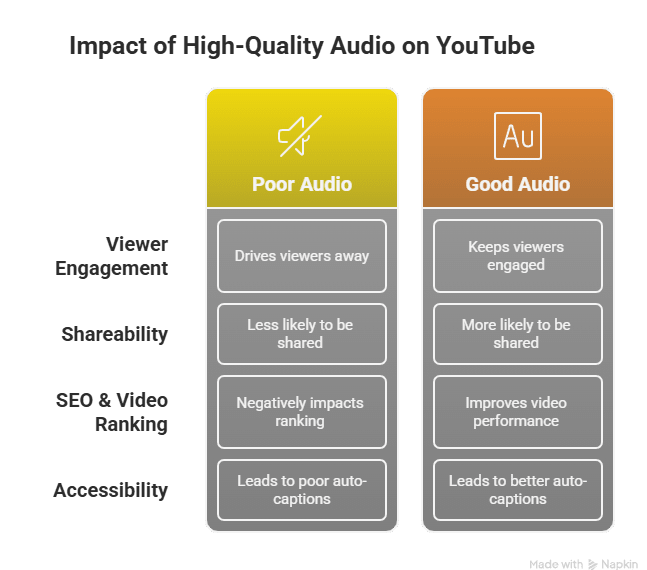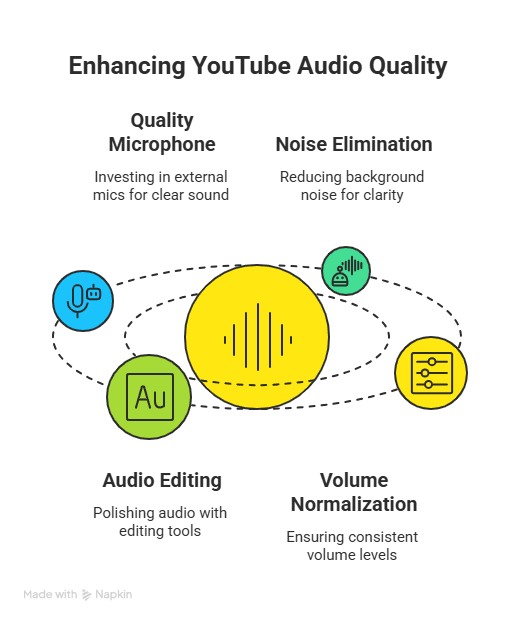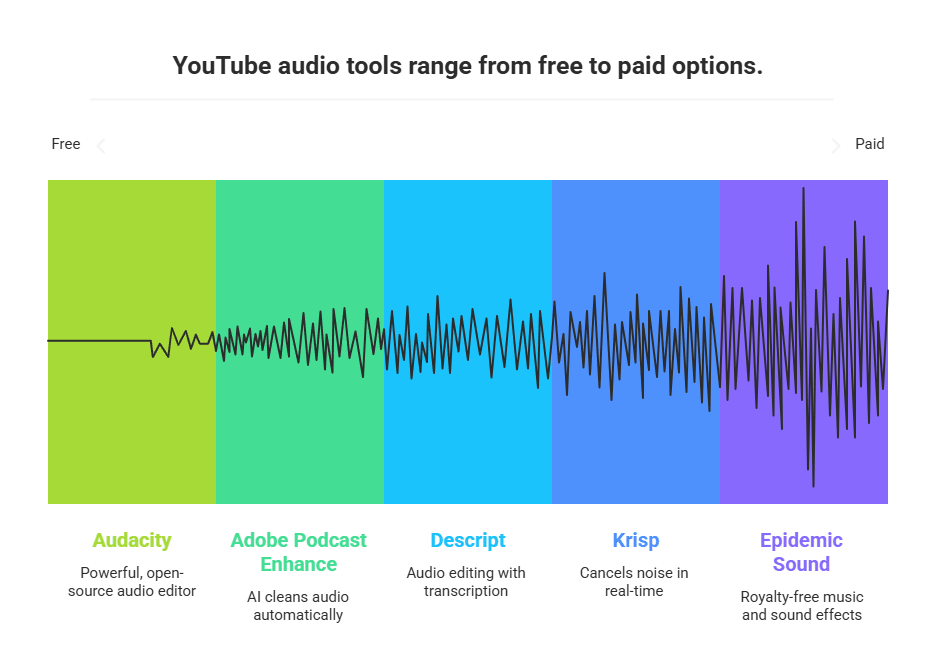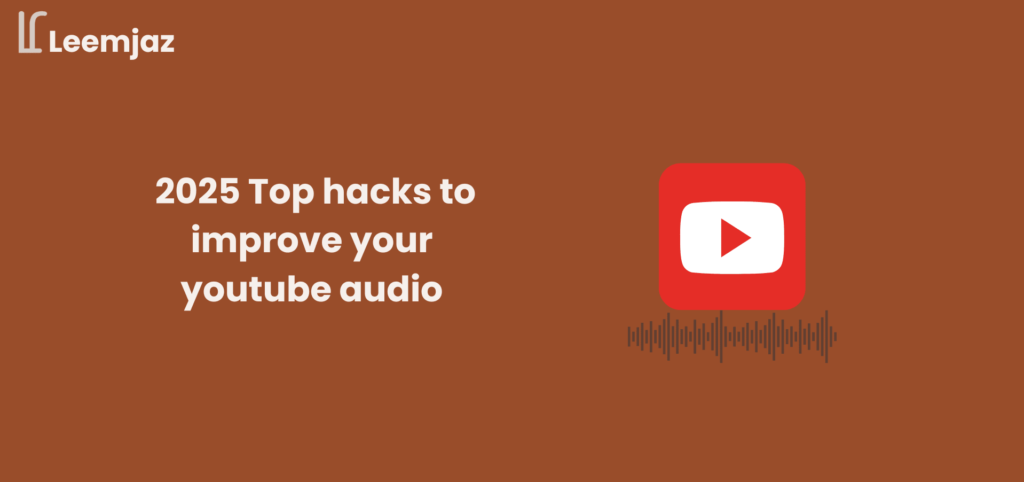Struggling with poor audio quality in your YouTube videos? If your viewers can’t hear your message clearly, they’ll likely click away. Whether you’re recording a podcast, voiceover, or vlog, clear, crisp audio is essential for retaining viewers and improving engagement. In this guide, we’ll walk you through everything you need to know about YouTube audio in 2025, why it matters, how to improve it, and the best tools to enhance your sound quality.
High-quality audio isn’t just a “nice to have” feature; it’s a must. In today’s competitive video landscape, viewers expect a professional audio experience. This post will help you elevate your sound and make your content stand out.
Why High-Quality Audio Matters for YouTube Videos in 2025

When it comes to video content, audio often gets overshadowed by visuals, but it’s just as crucial if not more. Here’s why audio quality is so important:
1. Boosts Viewer Engagement
Poor audio drives viewers away faster than poor visuals. When the sound is unclear or distorted, it creates frustration. Good audio keeps your audience engaged and helps them stay glued to your video, improving overall retention and watch time.
2. Increases Replay and Shareability
Videos with excellent audio are more likely to be shared and rewatched. When your audience enjoys the clarity of your sound, they are more likely to recommend your content, helping to grow your audience.
3. Improves SEO and Video Ranking
Longer watch times and better engagement positively affect your video’s ranking on YouTube. The more viewers stay and engage with your content, the better it performs in YouTube’s algorithm. Good audio plays a key role in making that happen.
4. Enhances Accessibility
High-quality audio leads to better auto-captions, making your content accessible to a wider audience. Subtitles and transcripts are essential for viewers who are hearing-impaired or non-native speakers.
What Is YouTube’s Audio Quality?
When you upload a video, YouTube compresses the original audio to ensure it streams efficiently across devices. This means YouTube converts audio into AAC format, typically with bitrates ranging from 128 kbps (for lower-quality videos) up to 384 kbps (for HD content).
While this compression reduces file size, it may slightly affect the depth of your audio. However, by following some simple practices, you can still ensure that your uploaded audio sounds excellent.
Pro Tip: Upload your video at a high bitrate to minimize audio loss during YouTube’s compression process. Aim for 192 kbps or higher for clearer sound.
How to Improve YouTube Audio for Maximum Engagement

Want to make sure your YouTube audio sounds professional? Follow these practical tips to ensure your content reaches its full potential:
1. Invest in a Quality Microphone
Good microphones are the foundation of clean audio. Built-in mics often pick up unwanted sounds, resulting in poor-quality audio. Invest in an external USB microphone, such as the Blue Yeti or Rode NT-USB, for clear, natural sound. If you want the highest quality, consider XLR microphones paired with an audio interface for a professional setup.
2. Eliminate Background Noise
Background noise is one of the most common problems in YouTube videos. Whether it’s traffic, pets, or the hum of an air conditioner, background noise can distract viewers. To combat this:
- Record in a quiet, controlled environment.
- Use acoustic foam panels or household items like blankets to reduce echo.
- Invest in noise reduction software or features in your editing tools to clean up any unwanted sounds.
3. Edit and Polish Your Audio
The editing phase is where you can transform your raw audio into professional-grade sound. Using tools like Audacity or Adobe Audition, you can:
- Normalize audio levels for consistency.
- Remove background noise or static.
- Cut out awkward silences or filler words.
- Enhance the overall clarity with equalization and compression.
4. Normalize Volume Levels
Volume inconsistency can drive viewers away. Normalize your audio to ensure a smooth listening experience. Aim for levels between 6 dB and -3 dB –to avoid sudden spikes or drops in volume. This will help maintain a consistent sound throughout your video.
YouTube Audio Library: Free Music and Effects
Did you know YouTube provides a free audio library for creators? It includes royalty free music and sound effects that you can use in your videos without worrying about copyright infringement.
What You’ll Find in the YouTube Audio Library:
- Music in various genres, from upbeat tracks to relaxing background music.
- Sound effects like footsteps, nature sounds, and ambiance.
- Safe for monetized videos as long as you follow the licensing terms.
You can access it here: YouTube Audio Library.
Audio-Only Content on YouTube: A Growing Trend
Did you know that YouTube supports audio only content? With the rise of podcasts, audiobooks, and other audio-focused channels, more creators are using YouTube to share their audio content. In fact, faceless content strategies are becoming more popular than ever. Learn how to make money online with faceless digital marketing in our full guide.
- Podcasts with static images.
- Narrated stories and audiobooks.
- Meditation and relaxation audio content.
This trend is an excellent opportunity for creators who want to reach new audiences with audio focused content. Whether you’re doing YouTube automation or publishing podcasts, these formats can help you expand your reach.
Common YouTube Audio Issues and How to Fix Them
Audio issues are common, but they can usually be fixed with a few simple steps. Here are some common problems and their solutions:
| Problem | Solution |
| Audio and video out of sync | Re-align audio and video tracks during editing. |
| Background echo | Record in smaller, padded spaces to minimize sound reflections. |
| Low audio volume | Normalize the audio during editing to balance levels. |
| Hiss or static noise | Apply noise reduction filters to clean up the sound. |
| Loss of quality after upload | Export the audio with the highest possible bitrate before uploading. |
Best Tools to Improve YouTube Audio in 2025

Several tools stand out for their quality and ease of use. Here are some of the best options for improving YouTube audio in 2025:
| Tool | Purpose | Free/Paid |
| Audacity | Audio editing and noise reduction | Free |
| Adobe Podcast Enhance | AI-based audio cleanup | Free (beta) |
| Descript | Audio editing and transcription | Freemium |
| Krisp | Real-time noise cancellation | Freemium |
| Epidemic Sound | Royalty-free music and sound effects | Paid |
These tools offer a range of features, from simple noise reduction to advanced audio enhancements, making them essential for YouTube creators looking to improve their audio.
How to Make Your YouTube Audio SEO-Friendly
While YouTube’s algorithm doesn’t directly measure audio quality, there are strategies to improve your content’s discoverability:
- Speak clearly so YouTube captions can transcribe your words accurately.
- Upload subtitles or transcripts to help with indexing and accessibility.
- Use relevant keywords in your video title, description, and tags.
- Mention your topic early in the video to boost relevance and search visibility.
By improving your metadata and transcripts, you can help YouTube understand your video content, boosting both visibility and accessibility.
FAQs About YouTube Audio
- Why does my YouTube audio sound bad after uploading?
YouTube compresses audio to optimize streaming, which may reduce quality. To minimize this, upload at a higher bitrate. - No. You should always use royalty-free or properly licensed music to avoid copyright issues. A good option is YouTube’s Audio Library, which offers free tracks that are safe for monetized videos.
- To add music to your video:
- Open YouTube Studio
- Click on Content and select the video you want to edit
- Go to the Editor section
- Click the music note icon
- Browse or search the Audio Library and choose a track
- Click Add to insert the music
- Adjust the timing and volume as needed
- Click Save to apply the changes
- What format does YouTube use for audio?
YouTube converts audio to AAC format, typically at 128 kbps or higher, depending on the video quality. - Can I upload audio-only content to YouTube?
Yes, YouTube allows audio-only content like podcasts and audiobooks with a static image or background. - What tools do YouTubers use to improve audio?
Popular tools include Audacity, Descript, Adobe Podcast Enhance, and Krisp.
Conclusion:
In 2025, YouTube audio is more important than ever. Whether you’re creating podcasts, tutorials, vlogs, or automated content, your audio quality can significantly impact your engagement and growth. Investing in the right tools, improving your editing workflow, and understanding YouTube’s compression system will give your videos a clear edge.
Ready to take your YouTube audio to the next level? Start optimizing your sound today, and watch your engagement and retention soar.
If you’re editing your videos in Canva, don’t miss our complete guide on how to add music to your video on Canva. It’s quick, easy, and beginner friendly.
